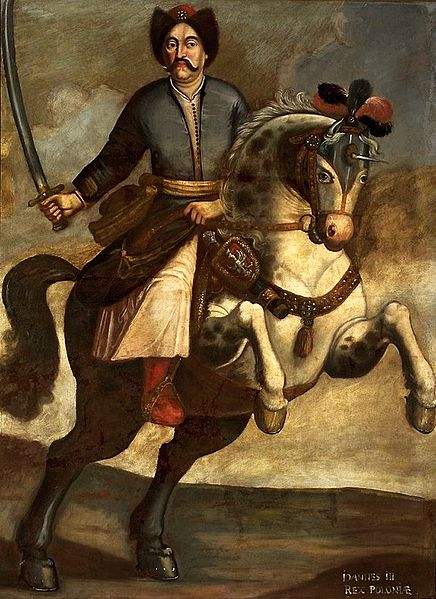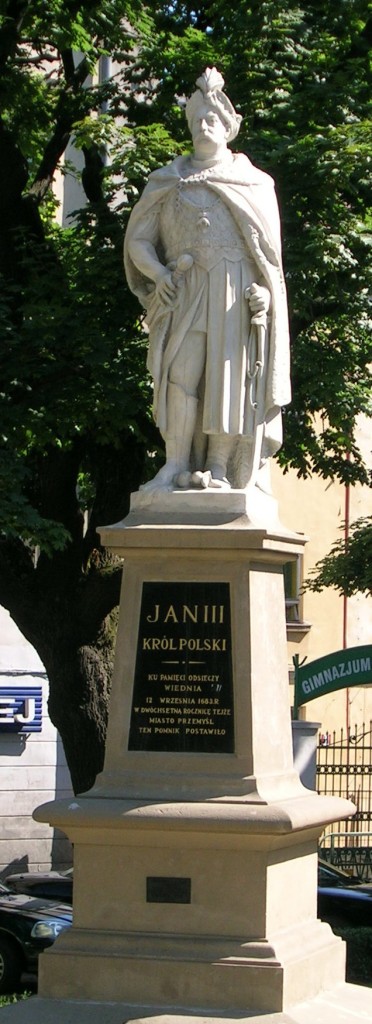John III Sobieski
When, in 1672, under Michael Wisniowiecki’s reign, the Turks seized Kamieniec, Sobieski beat them again and again, till at the crowning victory of Chocim they lost 20,000 men and a great many guns. This gave Poland breathing space, and Sobieski became a national hero, so that, King Michael dying at that time, he was unanimously elected king in 1674. Before his coronation he was forced to drive back the Turkish hordes, that had once more invaded the country; he beat them at Lemberg in 1675, arriving in time to raise siege of Trembowla, and to save Chrzanowski and his heroic wife, its defenders. Scarcely crowned, he hastened to fight in the Ruthenian provinces. Having too few soldiers (20,000) to attack the Turks, who were ten to one, he wore them out, entrenching himself at Zurawno, letting the enemy hem him in for a fortnight, extricating himself with marvellous skill and courage, and finally regaining by treaty a good part of the Ukraine.
For some time there was peace: the Turks had learned to dread the “Unvanquished Northern Lion”, and Poland, too was exhausted. But soon the Sultan turned his arms against Austria. Passing through Hungary, a great part which had for one hundred and fifty years been in Turkish hands, and enormous army, reckoned at from 210,000 to 300,000 men (the latter figures are Sobieski’s) marched forward. The Emperor Leopold fled from Vienna, and begged Sobieski’s aid, which the papal nuncio also implored. Though dissuaded by Louis XIV, whose policy was always hostile to Austria, Sobieski hesitated not a instant. Meanwhile (July, 1683) the Grand Vizier Kara Mustapha, had arrived before Vienna, and laid siege to the city, defended by the valiant Imperial General Count Stahremberg, with a garrison of only 15,000 men, exposed to the horrors of disease and fire, as well as to hostile attacks.
Sobieski started to the rescue in August, taking his son James with him; passing by Our Lady’s sanctuary at Czefistochowa, the troops prayed for a blessing on their arms; and in the beginning of September, having crossed the Danube and joined forces with the German armies under John George, Elector of Saxony, and Prince Charles of Lorraine, they approached Vienna. On 11 Sept., Sobieski was on the heights of Kahlenberg, near the city, and the next day he gave battle in the plain below, with an army of not more than 76,000 men, the German forming the left wing and the Pole under Hetmans Jahonowski and Sieniawski, with General Katski in command of the artillery, forming the right. The hussars charged with their usual impetuosity, but the dense masses of the foe were impenetrable. Their retreat was taken for flight by the Turks, who rushed forward in pursuit; the hussars turned upon them with reinforcements and charged again, when their shouts made known that the “Northern Lion” was on the field and the Turks fled, panic-stricken, with Sobieski’s horsemen still in pursuit. Still the battle raged for a time along all the line; both sides fought bravely, and the king was everywhere commanding, fighting, encouraging his men and urging them forward. He was the first to storm the camp: Kara Mustapha had escaped with his life, but he received the bow-string in Belgrade some months later. The Turks were routed, Vienna and Christendom saved, and the news sent to the pope and along with the Standard of the Prophet, taken by Sobieski, who himself had heard Mass in the morning.

Prostrate with outstretched arms, he declared that it was God’s cause he was fighting for, and ascribed the victory (Veni, vidi, Deus vicit — his letter to Innocent XI) to Him alone. Next day he entered Vienna, acclaimed by the people as their saviour. Leopold, displeased that the Polish king should have all the glory, condescended to visit and thank him, but treated his son James and the Polish hetmans with extreme and haughty coldness. Sobieski, though deeply offended, pursued the Turks into Hungary, attacked and took Ostrzyhom after the a second battle, and returned to winter in Poland, with immense spoils taken in the Turkish camp. These and the glory shed upon the nation were all the immediate advantages of the great victory. The Ottoman danger had vanished forever. The war still went on: step by step the foe was driven back, and sixteen years later Kamieniec and the whole of Podolia were restored to Poland. But Sobieski did not live to see this triumph. In vain had he again and again attempted to retake Kamieniec, and even had built a stronghold to destroy its strategic value; this fortress enabled the Tatars to raid the Ruthenian provinces upon several occasions, even to the gates of Lemberg. He was also forced by treaty to give up Kieff to Russia in 1686; nor did he succeed in securing the crown for his son James. His last days were spent in the bosom of his family, at his castle of Wilanow, where he died in 1696, broken down by political strife as much as by illness. His wife, a Frenchwoman, the widow of John Zamoyski, Marie-Casimire, though not worthy of so great a hero, was tenderly beloved by him, as his letters show: she influenced him greatly and not always wisely. His family is now extinct. Charles Edward, the Young Pretender, was his great-grandson — his son James’ daughter, Clementine, having married James Stuart in 1719.

